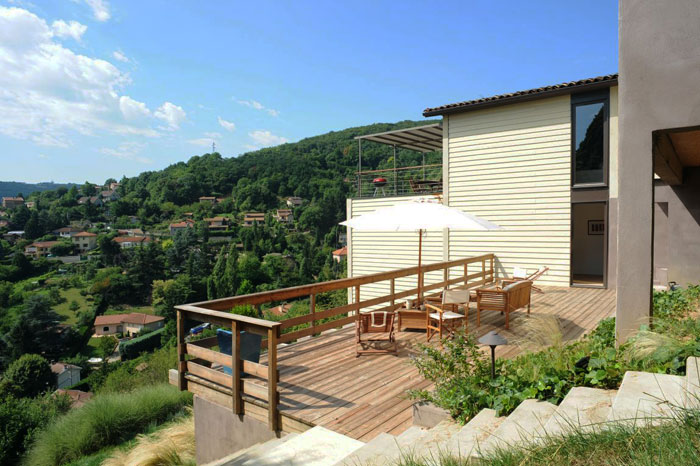The construction of a building necessarily involves the acquisition of land lot, which, depending on its location, orientation, vegetation, basement, easements, etc. – will profoundly influence the possibilities or limits of construction, and its overall cost at construction and for long-term maintenance. Here is an overview of the different points to take into account to choose a plot of land.
The land lot plays a fundamental role in the architectural design of a house or building: it is therefore necessary to think of the plot of land and building as a global project, in practical as well as aesthetic and financial terms, before embarking on the purchase of land and construction.
The first condition for a land lot to receive any construction is that it should be buildable, that is to say defined as buildable in the cadaster by the territorial authorities, of a sufficient size and linked to roads and connections to utilities networks: drinking water, electricity, sewage and telecommunications.
However, the possibility to build upon a plot of land is not sufficient to guarantee a construction permit for a house or building. To avoid the cost of buying a land lot in case of refusal of construction permit by the local authorities, a suspension clause must be added to the preliminary contract for the sale of the land – or compromise or promise of sale – to commit to the final purchase of the land only under reserve for grant the construction permit.
Characteristics of a land lot
A parcel of land can be sold with different qualities, depending on whether it is land in subdivision, or as land outside subdivision, an “isolated” land lot. Depending on the country, a land lot sold in subdivision may fall under certain obligations as to its characteristics. It is usually, if not compulsorily in certain countries, sold bounded and serviced, but rules of construction often limit the architectural possibilities in the design of the house or building to be developed.
Conversely, isolated land will require verification of its servicing with accesses to public networks of roads, water, sewage, electricity and telecommunications. If it does not have those accesses, the land lot will have to be bounded and serviced; but the freedom of construction and architecture will usually also be greater. Moreover, depending on countries, a land lot may be called “ready to build” if the seller guarantees its buildability – legally buildable, sufficiently large and linked to roads and utilities networks.
The characteristics of a land lot will have important consequences on the possibilities of architectural design. The environment, the integration in a subdivision or not, the orientation, the shape, the slope and the nature of the ground will all be parameters to take into account for the realization of a house or building.
The price
Of course, the price of a land lot is most often the first criterion of choice. It depends above all on its size and dimensions, its shape and configuration, the local market – large city or countryside, suburbs or center, and so on. – as well as the different characteristics of the environment – view, nature, proximity to useful or harmful infrastructure, etc. – of the nature of the ground.
The size
The size of a plot of land is a primary factor in its price. Although a land lot in subdivision is usually sold with defined boundaries and its size already been measured legally by an expert surveyor, this is not always the case for an isolated land lot. Be careful, therefore, to obtain a certification of its boundaries drawn up by a legally-mandated expert surveyor or, or if it is not available, to have it realized.

Only the opinion of an expert surveyor with legal authorities has validity to guarantee the boundaries of a land lot. This point can be especially tricky in some countries or areas where land possessions and boundaries are not well defined and/or registered with a reliable legal entity.
The location
The location of the land has a significant impact on the day-to-day lifestyle it will enable or potentially impose. The environment and climate, the residential, urban or rural environment, the proximity to transport, schools, shops, workplace or nature will facilitate certain activities rather than others and will modify the perceptions and valuations of current and future owners. Buyers should anticipate these parameters according to their lifestyle: duration of transport for the various daily activities, calm or ease of access for important activities, beautiful views, presence or proximity of nature for activities in the open air…
The orientation
The orientation towards the sun will have a great importance on maintenance costs over the years, especially for heating and/or cooling. Similarly, exposure to winds needs to be well assessed, as they can be vectors of rain, noise or odors. A good architect will be able to take advantage of the characteristics of a land – exposure to the south, stained-glass windows facing the sun, etc. – and to minimize its shortcomings – secondary rooms and few windows to the north, insulation of the winds, etc. – to improve the comfort and reduce the energy bills.
The configuration
The particular configuration of the terrain can be both a source of advantages or problems for the use of a lot land lot during construction: some sloping lands can offer a beautiful view, others are flat but blinded by their surroundings; sloping or narrow terrain can be a source of additional costs due to difficult access for vehicle or maneuvers, needs for leveling up or down. In addition, certain land lots may have vis-a-vis, restrictions for special building or mandatory requirements from neighboring plots of lands, protected environments, etc. So be sure to consult the local authority in charge before committing to buying a land lot.

Access to roads and utilities networks
Beware of land lots that are too far from existing equipment, newly classified as buildable, sloping or landlocked areas, as they can be sources of additional costs for the connection to roads and utilities networks: access to vehicles, water, electricity, telecommunications, sewage. These costs can become prohibitive for land plots that are too far from existing networks.
The nature of the ground
It is imperative to know the nature of the ground and soil before committing, because the quality of the soil will strongly influence the future construction costs without always being evident during a visit. If a rocky or sandy soil makes it possible to build without worries, except in the basement, a clay soil or with important leveling up will be the source of troubles that need to be addressed during the design.
Poor soils may result in additional costs for certain works, particularly foundations, imperative draining in case of high humidity or presence of ground water, cleaning of polluted soils by prior industrial use, consolidation of unstable parts of the ground…
Hazards of certain terrains
In some countries, the seller of a land lot has a legal obligation to declare a prior mining or industrial operation. However, in certain countries this is not the case or the authorities do not have the means to enforce such obligations.
It is therefore important to verify for the exposure to such hazards in particularly sensitive areas: flooding near rivers or in coastal areas, hurricanes or typhoons in tropical countries, landslides in heavy rains areas and/or mountainous areas with cleared forests, earthquakes or volcanic risks, etc.
Legal information on land: land regulation
Administrative regulation of all land in a given country is usually governed by some documents which can be available upon request or consultation with the competent authorities, at a cost or free of charge, depending on countries. It is imperative to be well informed on the land lot one intends to buy and therefore to obtain this information from the local authorities before taking any step in the buying process.
In certain countries, the competent authority may not be well defined, and/or the documents ensuring property rules may not be well kept or up-to-date, it is thus even more critical in such countries to understand the legal and official process of property ownership and/or use, as well as the sale and purchase regulation.
The laws and regulations governing land and the rights to use it generally fall under the following categories:
- Ability to build or not on a specific plot of land. Depending on geographic or legal specificity, certain land lots may not allow construction: protected areas and natural parks, areas unfit for construction, zones defined for public use, etc.
- Rights and obligations related to the use of a particular land lot: some land lots may require to enable passage for vehicle or people, utilities or sewage, they may limit the size or height of construction, as well as the type and/or style of construction, etc.
- Taxes and financial participation relative to the ownership and/or use of a certain plot of land.
The cadaster
In many countries, the document that lists all the land and its characteristics – size, orientation, boundaries with the public roads and neighboring parcels – Is called the “cadaster”. In any case, whatever the cadaster may say, only the demarcation of a land by a legally recognized expert has a legal value with regard to the delimitation of a land.
The preliminary contract for the sale of a land lot
The sale of a plot of land must be carried out by signing an authentic deed with a notary.I It certain countries, a preliminary contract of sale, a compromise of sale or a promise to sell must fist be agreed upon by the buyer and seller. The preliminary sale contract must state the conditions of sale, the price and suspension clauses that could render the contract void.
The assistance by a qualified professional for the preparation of the preliminary contract, a notary in particular, is highly suggested. He is obliged to inform the buyer and the seller of their rights and obligations, he must advise them to draft the clauses of the contract, and the cost of drafting the preliminary contract may be free as it is already included in the notary’s emoluments for the final sale.
The compromise of sale of a land lot
The pre-contract of sale of a land can take several forms, unilateral promise of sale, unilateral promise of purchase, or compromise of sale. The compromise of sale is the most used in practice because it engages the buyer and the seller, whereas the unilateral promises engage only one part for a period defined in the promise.
The compromise of sale, obliges the seller to sell a property at a defined price to the purchaser who undertakes to buy it. Although certain legal provisions allow unilateral or reciprocal withdrawal – withdrawal periods, suspension clauses or special conditions – the compromise definitively binds both parties at the time of signature. Usually, to be valid the compromise of sales must mention the following information:
- The complete civil records of the seller and the purchaser
- The address and cadaster references of the land lot
- The origin of the seller’s property – inheritance, donation, acquisition, etc. – with the date of the previous contract of sale, the name of the previous owner and the name of the notary who authenticated the deed
- The description of the land
- The price and the terms of payment – full payment at the time of the sale or not – with the contraction or not of one or more loans
- The amount, nature and disposition of the security deposit – or capital allowance – paid by the purchaser
- The deadline for the signature of the final sale
- The date of possession of the land
- The possible private servitudes: obligations of the owner/user to other parties, if any
- In the event of intervention by an intermediary – real estate agent, notary – the amount and information concerning the commission amount and payer
- The list of conditions which would enable the purchaser to withdraw unilaterally if they cannot be fulfilled. Such conditions may describe a specific event, future and / or uncertain event and independent of the seller and the buyer.
In the case of a land sold to be built upon, the most usual conditions precedent are:
- Obtaining a mortgage, if the purchaser wishes to finance the purchase or the construction by a loan, this legal condition often applies even if it is not registered in the pre-sales compromise
- Obtaining a land certificate for carrying out the construction planned
- Obtaining the building permit for carrying out the proposed works
- The absence of public pre-emption by the municipality or by another tenant
- The absence of certain condictions that may be too restrictive or too depreciating to the land plot’s value
- The resale of another property and, if necessary, the obtaining of a credit
- The survival of the purchaser at the time of the signature of the authentic deed of sale from the notary
The buyer generally pays a percentage of the selling price to the seller when signing the preliminary contract, a security deposit at the time of signing the compromise of sale or indemnity of immobilization in the case of a promise of sale. This initial payment, held as collateral by a third party – notary or real estate agent – until the day of the sale, is usually 10% of the total price, but it can be negotiated just like the amount paid on the day of sale.
Property Taxes
Make sure to know about any easements – vehicle passage, underground cables or pipes, etc. – which a land lot might be subject to, as well as any local tax imposed to the land lot, the construction upon it and the right to use or live in it. Property tax on the land, built-up property, and the residence tax can also greatly impact the real lifetime value of a land lot.




